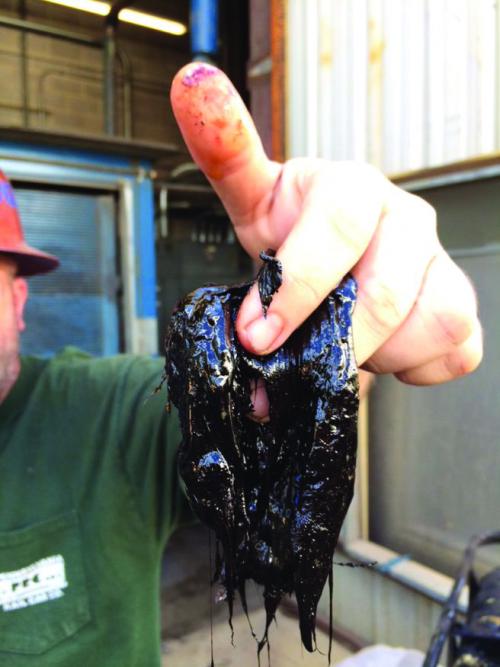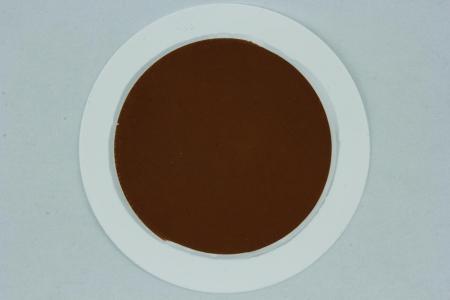Varnish is a leading cause of airend failure in oil-flooded/injected rotary-screw air compressors. The purpose of this article is not to cover every scenario conducive to varnish formation, but to point out that many factors need to be considered when it occurs, and methods are available for its detection. Ultimately, it’s up to both the oil manufacturer and maintenance professional to ensure the oil used is up to the task of resisting varnish and maximizing air compressor performance and life.
Common Signs and Causes of Varnish
Plugged filters, or an unexplained increase in discharge temperature, are late-stage indicators that varnish is present. In worst-case scenarios, varnish will glue the airend together, making it impossible to restart after the machine cools requiring disassembly for cleaning or airend replacement. Poor-quality oil is often to blame when varnish appears. Bad, poor or no preventive maintenance is an equally likely cause.
The lubricated components in an airend are quite simple and would easily survive in less severe environments using a basic light oil with sufficient rust and oxidation inhibitors. Rotary-screw air compressors present a substantially harsher operating environment compared to other high-speed applications. In an air compressor, high levels of heat and moisture act together with foaming, air entrainment and vaporization to greatly accelerate the natural oxidation process. Oil designers counteract these inherent problems with a blend of base oils and additives.
Hydrocarbon-derived base oils are most likely to form varnish in air compressors. They include American Petroleum Institute (API) Group I and II conventional oils, and Group III and (IV PAO) synthetic oils. Groups I and II will be advertised by air compressor oil manufacturers as mineral based and assigned a drain interval of 4,000 to 6,000 hours. Groups III and IV synthetics will likely be advertised as 8,000-hour oil and be specified as synthetic or PAO-based in marketing materials. There are also combinations of these base oils that are sold as semi-synthetic. Whatever the base oil, the consensus is synthetic oils will last longest in air compressor service under the same conditions.
Define “Normal” Operating Conditions
This discussion will center on 8,000-hour synthetic oils built with Group III, Group IV or a combination of the two for the varnish discussion. Oils of this type are very popular and have a long track record of success in general air compressor service. They are a mid-range class of oils built to reach their advertised drain interval with sustained discharge temperatures of 170°F to 212°F.
Most industrial-oil manufacturers produce at least one and most likely several oils of this class. Some manufacturers are specific about the operating conditions the oil is designed for and others are not. It’s common for air compressor oils to be recommended for a specified number of hours “under normal conditions.” Statements like this encompass the wide range of operating conditions that exist in the field, so it’s important to determine what the oil manufacturer’s definition of “normal” is before adopting maintenance practices for a new oil. The best way to learn more about any oil is to talk to the manufacturer.
Next, let’s discuss ways to prevent varnish in your rotary screw air compressors.
Choosing the Correct Oil
The two most important things you can do to prevent varnish are choose the correct oil for your unique operating conditions and adapt your maintenance practices to those operating conditions. If your machine has been running the same synthetic oil trouble-free for years and the oil reaches its advertised drain interval, your maintenance practices, operating environment and oil quality are obviously working well together. There would be no need to change anything from an operational perspective, but a desire to change oil suppliers may be driven by price or other supplier-related issues.
Don’t hesitate to ask any potential new supplier for evidence of their oil’s performance. That evidence will most likely be data obtained through testing in rotary screw air compressors and or bench test results. Data from the rotary screw air compressor test may include oil analysis results throughout an 8,000 hour or longer test period with the test conditions provided. Lab bench tests may also be included describing the test conditions and relevance of the test to air compressor operation.
Resist the temptation to rely on the results of a single simple test such as the Rotating Pressure Vessel Oxidation Test (RPVOT). The RPVOT is designed to measure the remaining useful life of turbine oils. However, it used with new oils to suggest useful life. In theory, the higher the minutes the oxidation resistance of an oil survives in this test, the longer the oil will last in service. The correlation between this test’s results and actual field performance is not established and is completely unreliable. Tests such as these should be considered as one of many data points and not the determining factor of oil quality.
Proper Maintenance Practices Often Solve Problems
If your synthetic air compressor oil is giving you problems, first review your maintenance practices. In most cases, proper maintenance can solve the problem. Also consider the source of the intake air. Is the air compressor taking in fumes, smoke or other airborne contaminants? After reviewing your air compressor holistically, your last option is to consider changing oils. Your options will likely be more expensive, but the time saved and potential damage avoided can make them well worth the added expense.
Here are two examples of when changing oil types may be prudent:
Example No. 1 - heat: High temperatures reduce oil life and cause varnish. The hotter the temperature, the more frequently the oil should be changed. If your air compressor discharge temperature is in the range of 212°F or hotter and you are experiencing varnish issues, you may want to consider an ester type oil such as a Polyolester (POE). These oils do well controlling varnish and they last a long time. But they come at a higher price.
Example No. 2 - water: Operating in a high-humidity environment with short duty cycles, low discharge temperatures and poor maintenance practices can also force a change in oil type. Air compressor oil manufacturers often refer to their products’ “fast water separation.” Oil mixed with high levels of water will oxidize at a phenomenal rate and eventually produce thick, damaging goo that contains the same oxidative components as varnish. To prevent the problem, Group III or IV oils are designed to cleanly release water without forming an emulsion, allowing it to be periodically drained from the bottom of the reservoir. Some maintenance staff just don’t know this or can’t do it for operational reasons. Simply raising an abnormally low discharge temperature per the air compressor OEM’s recommendation might take care of the problem. If not, you may want to consider converting to a Polyglycol (PAG)-based fluid.
PAG-based air compressor oils are excellent air compressor oils that don’t form varnish and have the ability to dissolve water without damaging the machine, eliminating the need for manual removal. They are also likely incompatible with Group III or IV type oils and a proper conversion process using an ester oil as an intermediary flush may be required. If you consider converting to a PAG or POE, consult the air compressor or oil manufacturer before doing so. Some machines are built with hoses, seals and other materials that are incompatible with them.

Excessive water and air compressor oil are a bad combination.
Cleaning Varnish From an Air Compressor
Whether your varnish and sludge problems were caused by using low-quality oil, the wrong type of oil for your conditions or incorrect maintenance practices, cleaning a dirty air compressor before introducing new oil is crucial.
Draining and refilling will not do the job adequately. It’s important to remove as many of the oxidative byproducts remaining from the failed oil as possible since they can accelerate the oxidation of the new oil, severely shortening its service life. Many commercial cleaners are available and should be used per the manufacturer's instructions.
ASTM D7843 Test Method for Detecting Varnish
Besides periodic visual inspection, your last line of defense against varnish is oil analysis. Routine oil analysis will check viscosity, acid number, water, additive metals, wear metals and possibly oxidation. The results are compared to the new oil baseline and anything out of the ordinary is flagged against established limits. Most labs will recommend actions based on the analysis ranging from no action to changing the oil.
Two primary indicators that an oil is reaching its end are kinematic viscosity and acid number. When they begin to rise, they will be flagged. The point at which the oil will become unserviceable is difficult to predict since the rise may be slow and steady or exponential. However, In the case of varnish these numbers can remain normal and you’d never suspect a problem exists.
Fortunately, another tool is available to help detect varnish. The ASTM D7843 test method uses membrane patch colorimetry (MPC) to measure the varnish potential of oil. The oil is prepped per the method and run through a membrane. The varnish-producing insoluble substances in the oil are captured and the color of the patch is assigned a rating of “Good,” “Monitor,” “Abnormal,” or “Critical.”
The test cost is reasonable, and it tells you what routine analysis cannot. It may not be practical to have this test run on every sample, but it is not unreasonable to check an oil you have no experience with every 2,000 hours until you establish it can handle your conditions. Be aware that if the machine has produced varnish previously and was not cleaned before the oil was changed, it’s possible your new oil will come back with a bad MPC result.

Shown are final MPC results from two oils tested after running at identical conditions for 2,000 hours. Both oils have normal acid and viscosity numbers. The darker patch represents an oil that has failed at 2,000 hours of testing and has developed the potential to produce varnish. The lighter patch is an oil that is at little to no risk of producing varnish after 2,000 hours of testing under the same conditions.
Defeating Varnish is Team Effort
Varnish is an unfortunate risk many maintenance professionals will deal with at some time when operating rotary screw air compressors. But, with MPC and the right oil, you can limit its formation and improve compressor life and performance. Ultimately, defeating varnish is a team effort. The lubricant manufacturer has to design an oil that will work for the conditions, the maintenance staff must employ appropriate preventive maintenance practices, and the oil analysis lab must provide accurate results, including MPC when appropriate.
About the Author
Mike Caruso is an Industrial Products Manager at AMSOIL INC. He has worked in industrial product development at AMSOIL INC. for ten years and holds Society of Tribologists and Lubrication Engineers Certified Lubrication Specialist (CLS) and Oil Monitoring Analysts I (OMA 1) certifications; email: mcaruso@amsoil.com.
About AMSOIL INC.
AMSOIL INC. formulates advanced synthetic lubricants and performance products for those who demand the best. For more information, visit https://www.amsoil.com/.
All photos courtesy of AMSOIL INC.
To read more Air Compressor Lubrication Technology articles, please visit www.airbestpractices.com/technology/air-compressors.




